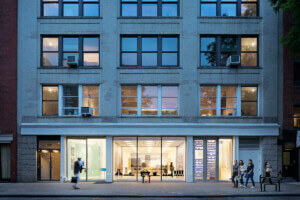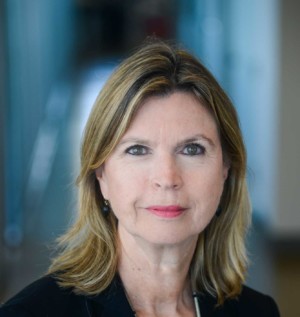The Architect’s Newspaper published its first issue on November 10, 2003. Founded by Bill Menking and Diana Darling, the operation has grown into AN Media Group. Throughout its 20- year history, Darling has been a leader, ideating and delivering new publications, products, newsletters, and events. Gina Pollara, who briefly worked at the company with her, sat down to talk about this milestone.
Gina Pollara (GP): Tell me about your leadership of The Architect’s Newspaper. You were always handling the financial side of things, but tell me about your creative contributions.
Diana Darling (DD): My years in the fashion industry taught me a lot about branding and reproduction quality. Over the past 20 years, I’ve created or co-created everything we’ve done: the newspaper, its regional editions, our newsletters, and the conferences were my idea. I am most comfortable leading sales and marketing. I feel motivated when I’m solving problems and innovating. I’ve grown the newspaper into a media company beyond what we originally imagined when we published our first issue.
New ideas have a life of their own; sometimes they work like our Facades+ brand, and sometimes they come to an end. I love the idea of making things, so years ago I started a newsletter called Fabrikator that ran its course. Later, in 2012, we started our Facades+ conferences with a big event in New York. We’re wrapping up our 11th year now, and that has been a big part of our business, both in terms of focus and revenue. Without Facades+, we might not be in business. You can’t just have a print publication by itself anymore. During the pandemic, we rolled out a lot of virtual events and since then we do a lot of webinars and continuing education through virtual events. It’s been amazing to reach our community using these new platforms.
I still contribute my ideas for editorial input, especially for AN Interior. That brand is about creativity and has a cultural and lifestyle component. Something we often talk about internally is how division of The Architects Newspaper is more about words, while AN Interior is about pictures. I’m involved in many aspects of AN Interior, which feels comfortable to me as I previously worked in fashion publishing.
GP: How did you get your start working in media?
DD: Prior to starting AN, I worked in retail marketing. I produced print catalogues in the heyday of direct mail. My first job out of college was with Neiman Marcus Catalog in Dallas. For more than 20 years I was involved in buying paper, creating production schedules, handling circulation, and controlling creative budgets. From that experience I understood how to produce a print publication. I always wanted my own business, so the idea of starting a publication with Bill mixed both of our knowledge and strengths. Bill brought architectural history, writing experience, and industry connections, and I brought the business acumen of developing media products, reaching the audience, and getting money in the door.
GP: When did you get the idea to start The Architect’s Newspaper?
DD: When I met Bill in 1990, he was writing for a London-based magazine called Building Design, and we were friendly with the editor, Paul Finch. At one point, Paul suggested that we should start a publication like Building Design in the United States. We moved back to New York in 2002 when I had a bit of severance money, and realized if AN was going to happen, we needed to dedicate real time to it. We must have worked on it for about a year before bringing on Cathy Lang Ho to jumpstart the editorial department along with Bill, and she invited Martin Perrin to be the first art director.
We thought we could publish a paper 20 times a year in each region of the U.S., and we thought we were going to sell advertising with one person! We were ambitious, we didn’t have a clue.
GP: You started the paper from your loft in Tribeca. What was that like?
DD: We were all located over the place. Bill and Cathy were in the front office, and I was in a little office in the middle of the space. And the others were in this little side apartment that we called our “back office.” We didn’t have a decent internet connection, and we didn’t even have a phone system that connected the front and back offices. One of the perks of the job was doing your laundry at work. I don’t think our daughter liked having this circus around all the time.
GP: What’s the biggest thing in the architectural world that has changed since you started the newspaper?
DD: There has been a shift in who is here and relevant, which is always going to be the case. People have retired, and there are new publications. The scene is not the same. We’ve explored different routes like podcasts and video, and of course social media is so important today. I’ve always believed in bootstrapping. When we were first starting, I heard someone say that when you have a media company, you have to stack dimes. And that’s what I have always believed and tried to adhere to: Developing a lot of revenue streams with high margins. It sounds as though you have been responsive to these major changes in how media companies can survive. You have to stay relevant. Being independent keeps us nimble. If we want to try something, we go for it; we don’t have to go to corporate to get decisions made. I see solutions quickly and then decide what to do next. It has not been easy, and I sweated every payroll until 2013.
GP: How did you balance your career and being a parent? Nowadays more men are confronted with that challenge whereas before it was just on women, right?
DD: Bill would take our daughter, Halle, to school every day by bicycle. I didn’t leave every day at 3:00 p.m. when school was over; I was focused on making the newspaper successful.
This is the struggle of modern life: We want to work and raise a family at the same time. It was important to Bill and me that we gathered every evening for dinner. The business talk would come up, and it was fun to talk about. But then Halle would inevitably ask, “Can you just talk about something else?” In hindsight, I wish I had paid more attention to Halle during those years. I am making up for lost time now and being present with her is a priority for me.
GP: It must have been challenging for you to have lost Bill and still keep the newspaper running.
DD: Bill and I built this paper. A lot of people don’t know that. People automatically assumed it was all him. That was a struggle for me for many years. When I started Facades+, it was great to be out on my own and build a reputation for myself in the AEC community.
Bill brought in so much knowledge because he was out there, networking all over the place. He was the personality in front of the newspaper. It was who he was, but that isn’t me. It’s not my personality. He had a huge network of people that fed him information, in New York and all over the world; when he died, I didn’t know how to replace that. That part has always been challenging to me, while managing the business and the family. This is what I miss about Bill: his enthusiasm and charisma. There was always something new and exciting he was attending, traveling to, or working on. He was a unicorn, and he will never be replaced in my life in the same way.
But I have always been here behind the scenes, so I had to work to stay relevant after Bill died. Running the day-to-day operations, managing all departments, sales, finance, HR, IT, marketing, and keeping my eye on editorial… It’s a lot! I strive to keep AN relevant as I’m very competitive.
GP: How do you feel as a woman running an independent media company?
DD: I often feel as though I don’t get the acknowledgement that other men do in this publishing profession. From this side of the coin, things appear to be easier for men to achieve financial success. I have to maintain a holistic view and stay on top of everything to be sure we are presenting ourselves in an appropriate and competitive way. Bill was great at what he did, but he never looked at the spreadsheets. If I started talking numbers, his eyes would glaze over.
GP: Is there anything else we should mention?
DD: We have had a passionate and devoted team at AN from the beginning. It is ever changing, but Bill and I did not do this on our own. It was amazing to have Cathy Lang Ho to help jumpstart the paper and bring on Martin Perrin, who set a design style that carries on today. I am still in touch with prior editors like Julie Iovine and Matt Shaw and Sam Lubell, as they’re always ears I can depend on. And I could not have done this without Dionne Darling, my sister-in-law, who has managed sales and marketing for ten years and has been a huge support and asset for the business. I would like recognize Tara Newton, Heather Peters and Marty Wood, who have been with AN for over 5 years. And now Jack Murphy is leading the editorial team with lots of great ideas and passion. And a special call out to the 20 years of advertising support that continues to grow, as well the committed readers that continue to follow AN and all that we do.
It has been a wild and exciting ride and nothing like I thought my life would be after moving from Grand Prairie, Texas, to New York in 1987.
GP: What’s next for AN Media Group?
DD: I am excited to continue growing different parts of the business. I’d like to see us strengthen our existing platforms and stay true to our print legacy. There is always an idea to pursue, another phone call to make, and another story to tell.
Gina Pollara is a memorialist who studied architecture at the Cooper Union. She has worked on Louis Kahn’s FDR Memorial and the Triangle Fire Memorial.











